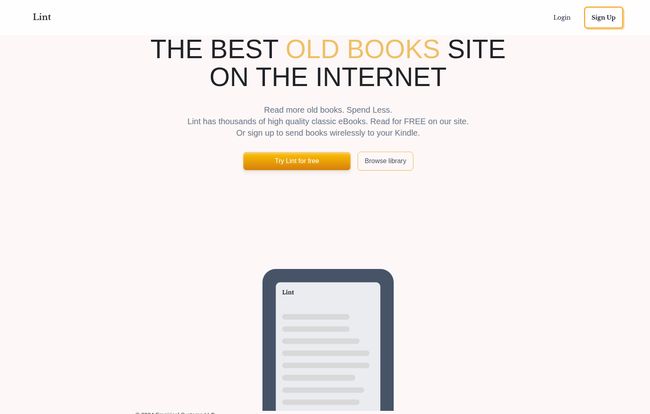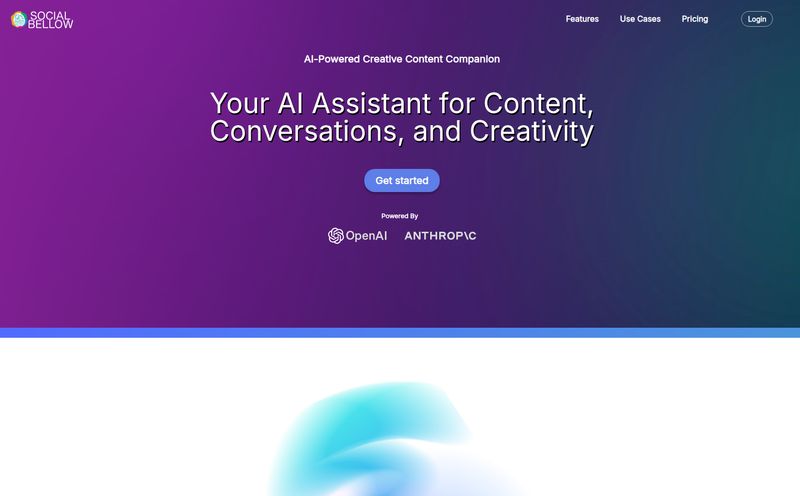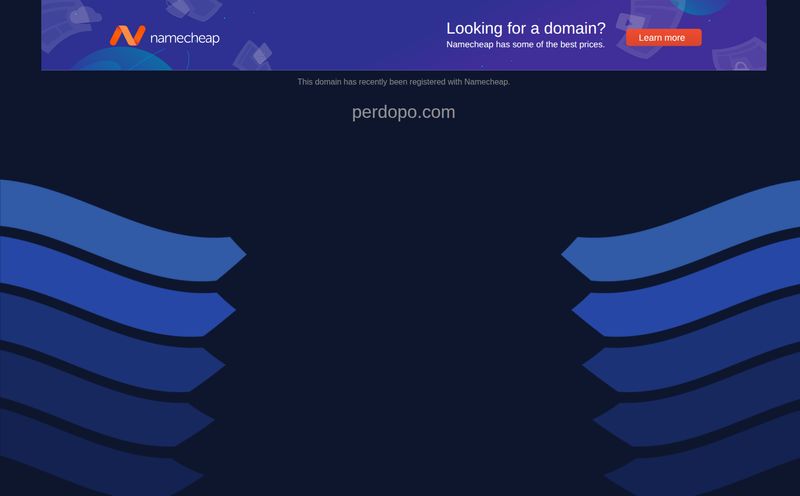That Digital Pile of Shame on Your Kindle? There’s a Tool For That.
Okay, let’s be real for a second. How many books are on your Kindle (or Kobo, or phone) right now that you swore you’d read? You bought them with the best of intentions. That biography everyone was talking about. That deep dive into ancient philosophy. That travel guide for a trip that never happened. Now they just sit there, a silent, digital monument to your ambition. It’s the modern version of tsundoku, the Japanese term for piling up unread books. And my Kindle is a prime offender.
I stumble across tools all the time that promise to revolutionize my reading, and frankly, most of them are just glorified PDF viewers. But then I came across a site called Lint. The landing page said something that hit me right in the feels: "You collected your library. Lint finds you time to read it." Well, challenge accepted.
Lint isn’t just another ebook store. It’s something different. Something… weirdly smart. And after playing around with it for a while, I think it might actually be one of the most interesting approaches to digital reading I’ve seen in years.

Visit Lint
So, What is This Lint Thing Anyway?
At its core, Lint is a platform for discovering and, more importantly, engaging with classic nonfiction ebooks. Think of all those amazing, copyright-free texts from places like Project Gutenberg—the foundational works of history, science, travel, and philosophy. Lint takes that massive, slightly intimidating library and turns it into something you can actually use. It’s not about buying new books; it's about re-discovering the old ones.
The platform has this nifty “shuffle” feature that serves you chapters and excerpts, almost like a literary slot machine. It’s a serendipity engine for your brain, helping you stumble upon ideas you didn't even know you were looking for. It’s this focus on classic, foundational texts that gives it a unique flavor. You won't find the latest bestseller here, and that's entirely the point.
The Real Magic: Building a Literary Mixtape
Here’s the part that made me sit up and pay attention. Lint lets you build custom ebooks. This is the killer feature, in my opinion.
Imagine you’re planning a trip to Italy. You could search Lint for "Rome," and instead of just getting a list of full books, it will pull individual chapters and relevant sections from dozens of classic travelogues, histories, and journals. You can then hand-pick the chapters that look most interesting—a chapter on the Colosseum from a 19th-century historian here, a reflection on Roman art from an old journal there—and Lint will stitch them together into a single, brand-new ebook. Your own personalized anthology.
It's like making a mixtape or a Spotify playlist, but for reading. You become the editor. You’re not just passively consuming a book; you’re actively creating a reading experience tailored to your exact curiosity. For a research junkie like me, this is an absolute game-changer. It turns a vast, unmanageable archive of classic literature into a sharp, precise research tool.
Finally, a Reason to Dust Off Your Kindle
The other half of the equation is the Kindle integration. Once you’ve built your perfect custom ebook on, say, the history of Japanese gardening, you can send it wirelessly to your Kindle with a click (this is a feature in their paid plans). This is huge. It bridges the gap between the interactive discovery on the website and the focused, distraction-free reading experience of an e-reader.
It’s a fantastic way to breathe new life into that device. Suddenly, my Kindle isn’t just a graveyard of impulsive Amazon purchases. It’s a curated library of custom-built texts that I’m genuinely excited to read. It makes the device feel personal again.
A Look at the Lint Pricing Structure
Now, the all-important question: what’s this going to cost? Lint operates on a freemium model, which I always appreciate. It lets you get your hands dirty before pulling out your wallet.
| Plan | Price | Key Features |
|---|---|---|
| Free Reader | $0 | Read on the site, create 1 'stack', upload up to 10 of your own books (100 MB storage). |
| Autodidact | $4.99 / month | Everything in Free, plus Send To Kindle, 5 stacks, upload up to 100 books (500 MB storage). |
| Collector | $9.99 / month | Everything in Autodidact, plus 50 stacks, upload up to 10,000 books (1 GB storage). |
The free tier is surprisingly generous. You can explore the library and even build one "stack" (which is what they call their custom ebooks) to see if you like the process. But for me, the Autodidact tier at five bucks a month is the sweet spot. The Send To Kindle feature is what makes the whole workflow click into place. The Collector tier is clearly for the power-users and digital archivists among us—and I know you're out there!
My Honest Take: The Good and The Niche
Look, no tool is perfect. I love the innovation behind Lint, I really do. The ability to create bespoke ebooks is genuinely brilliant. It’s a solution to a problem I think a lot of curious people have: how to efficiently mine old texts for specific information. The interface is clean, simple, and gets out of your way.
The main thing to be aware of is its focus. This is a tool for a specific type of reader. If you’re looking for contemporary fiction or the latest business books, this isn’t it. Lint is unapologetically for lovers of classic nonfiction. If you’re a student, a historian, a writer, a philosopher, or just a deeply curious person who loves old things, you will feel right at home. If not, it might not be for you, and that’s okay.
"I've always believed the best ideas are often found by connecting older, forgotten ones. Lint feels like a platform built on that very principle."
Some might also find the library a bit opaque at first—it’s not always clear just how many books are in there. But the discovery process is part of the charm. It rewards exploration.
Frequently Asked Questions About Lint
Is Lint really free to use?
Yes! The Free Reader plan lets you browse and read everything on the site and even build one custom ebook or 'stack'. You only need to pay if you want premium features like sending books to your Kindle or creating more stacks.
How does the custom ebook feature actually work?
You enter a search query, and Lint scans its library for relevant chapters and sections. It presents them to you in a list, and you can preview and select the ones you want. Once you're done, you hit 'build', and it compiles them into a single, cohesive ebook file for you.
What kinds of books will I find on Lint?
The library is focused on classic, public-domain nonfiction. Think historical accounts, scientific papers, travel journals from the 19th and early 20th centuries, philosophical treatises, and more. It's a treasure trove for researchers and history buffs.
Can I add my own ebooks to Lint?
Yes, you can! The platform allows you to upload your own ebooks (like .epub files), which helps you engage with books you already own. The amount you can upload depends on the pricing tier you choose.
What is a 'stack' in Lint?
A 'stack' is Lint's term for a custom ebook that you've built from various chapters and sources. The name evokes a 'stack of papers' or research you've collected on a single topic.
Is this only for Kindle users?
The wireless delivery is optimized for Kindle, which is a major draw. However, anyone can use the website to read and build ebooks. You could potentially download your custom ebook and sideload it onto other devices, but the seamless experience is definitely geared toward the Kindle ecosystem.
A Fresh Take on Old Words
In a world of endless content streams and algorithmic recommendations pushing the same handful of new titles, Lint feels like a quiet, thoughtful rebellion. It’s a tool that encourages you to slow down, to be more intentional with your reading, and to find new connections in old ideas.
It won't be for everyone, and it doesn’t try to be. But for the right kind of reader—the curious, the researcher, the autodidact—Lint is a powerful and elegantly designed tool. It finally gives us a way to not just collect a library, but to actually read it. And that, to me, is worth a whole lot.



